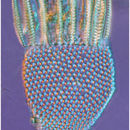en
names in breadcrumbs


Phaeodarea, or Phaeodaria, is a group of amoeboid cercozoan organisms. They are traditionally considered radiolarians,[1] but in molecular trees do not appear to be close relatives of the other groups, and are instead placed among the Cercozoa.[2] They are distinguished by the structure of their central capsule and by the presence of a phaeodium, an aggregate of waste particles within the cell.
The term "Radiozoa" has been used to refer to radiolaria when Phaeodarea is explicitly excluded.[3]
Phaeodarea produce hollow skeletons composed of amorphous silica and organic material, which rarely fossilize. The endoplasm is divided by a cape with three openings, of which one gives rise to feeding pseudopods, and the others let through bundles of microtubules that support the axopods. Unlike true radiolarians, there are no cross-bridges between them. They also lack symbiotic algae, generally living below the photic zone, and do not produce any strontium sulphate.
Through phylogenetic analyses it has been discovered that Phaeodarea is a monophyletic clade, but the historical orders and families comprising it aren't. Instead, the clade consists of 11 subclades defined by morphological and phylogenetic values that do not correspond with the traditional orders and families:[4]
clade A
clade B
clade C
clade D
clade E
clade F
clade G
clade H
clade I
clade J
clade K
Despite this, the current taxonomy by Cavalier-Smith maintains the original classification of suborders[5] divided between two new orders:[6][7]
The modern classification is the following, with the subclass containing a total of 2 orders, 7 suborders,[6][7] 16 families and 39 genera.[8]
Phaeodarea, or Phaeodaria, is a group of amoeboid cercozoan organisms. They are traditionally considered radiolarians, but in molecular trees do not appear to be close relatives of the other groups, and are instead placed among the Cercozoa. They are distinguished by the structure of their central capsule and by the presence of a phaeodium, an aggregate of waste particles within the cell.
The term "Radiozoa" has been used to refer to radiolaria when Phaeodarea is explicitly excluded.
Phaeodarea produce hollow skeletons composed of amorphous silica and organic material, which rarely fossilize. The endoplasm is divided by a cape with three openings, of which one gives rise to feeding pseudopods, and the others let through bundles of microtubules that support the axopods. Unlike true radiolarians, there are no cross-bridges between them. They also lack symbiotic algae, generally living below the photic zone, and do not produce any strontium sulphate.